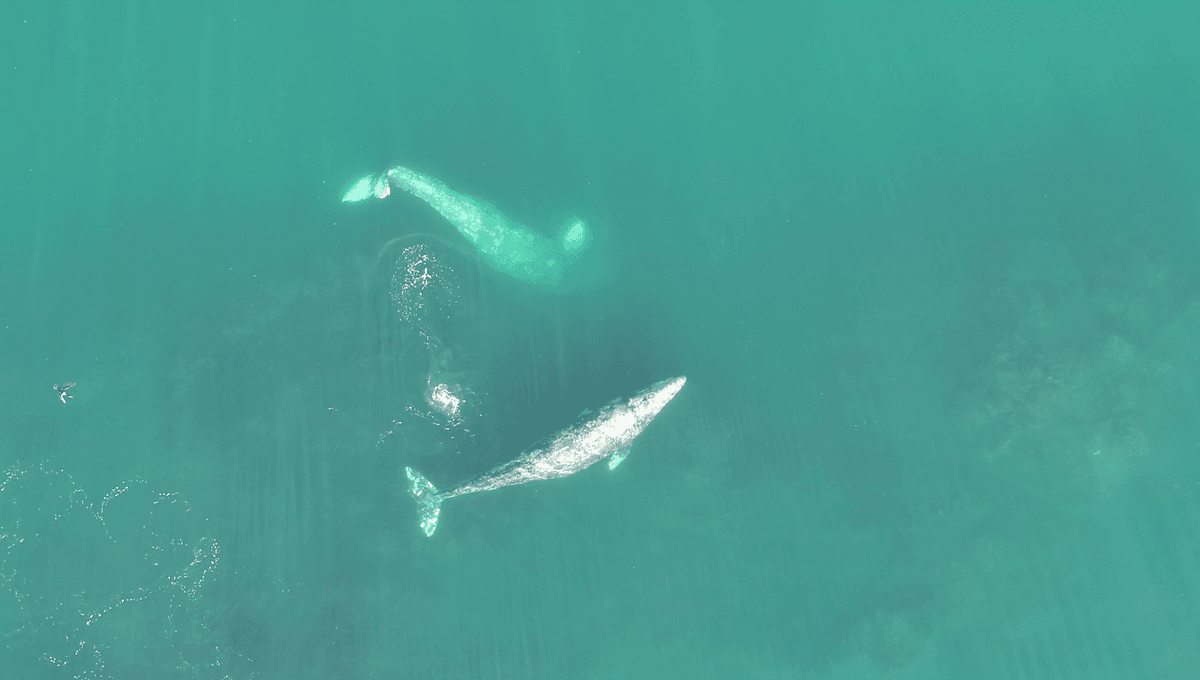
Whales have been up to all sorts this year, from joining the list of animals demonstrating tool use and accidentally almost scooping up seals to slapping people in the face. It seems that their antics have not slowed down, as researchers look into them doing acrobatic headstands.
Gray whales (Eschrichtius robustus) off the coast of Oregon, USA, have been observed over a seven-year period. By using drone footage, the researchers could study which foraging tactics the whales were using and found some surprising changes as the whales got older and as their body condition changed.
Feeding strategies such as forward and side swimming were used more by the younger and smaller whales. However, the bigger older whales were more likely to do headstands and push their mouths into the bottom of the sea floor. In fact headstanding was the most frequently seen foraging behavior and occurred in 56.4 percent of the 160 sightings.
“Our findings suggest that this headstanding behavior requires strength and coordination. For example, we often see whales sculling much like synchronized swimmers do while they are headstanding. It is likely this behavior is learned by the whales as they mature,” said Clara Bird, a researcher in the Marine Mammal Institute’s Geospatial Ecology of Marine Megafauna Laboratory, who led the research as part of her doctoral dissertation, in a statement. “We have footage of whale calves trying to copy this behavior and they’re not able to do it successfully.”
The gray whale population in question has been studied since 2015, and contains roughly 200 individuals. These whales do not travel to the Arctic, but remain as a subpopulation feeding in summer along the coast of Oregon, Washington, the top of California, and even Canada. This coastal habitat is relatively shallow and the whales use a range of feeding techniques to nab their prey.
As well as being related to the age and body condition of the whales, the feeding techniques are also related to the type of prey the whales are after. The team found that when feeding on mysid shrimp, the whales are more likely to do their headstands, as the shrimp collect on reefs.
Overall the team found that as the whales age and grow, they are much more likely to use headstanding as a foraging method, this is also increased with increased water depth and being in a reef habitat. The side-swimming tactic also increased with an increase in body length but was found to be used in rocky habitat the most, suggesting that older longer whales use this to access prey in these shallow areas since headstanding might not be possible due insufficient water depth.
“It’s been an amazing journey of discovery over the last 10 years learning about how cool these gray whales are. They are underwater acrobats, doing tight turns, upside-down swimming and headstands,” said study co-author Associate Professor Leigh Torres, who leads the GEMM Lab at Hatfield Marine Science Center in Newport. “We have now connected these behaviors with the habitat, size and age of the whale, which allows us to understand much more about why they go where they go and do what they do. This will help us protect them in the long run.”
Alongside headstands, whales can also perform what is known as a bubble blast. This is a single large exhalation that causes bubbles to rise to the surface of the water in a circle. Previously, this was thought to be done to collect prey or aid in prey capture – but the researchers have learnt that the bubble blasts actually help the whales maintain their buoyancy in shallow waters.
In fact the team found that longer more buoyant whales were more likely to bubble blast while headstanding, and that the headstanding and side-swimming dives were longer when a bubble blast was performed. Larger, longer whales have bigger lungs, that therefore hold more air, making them more buoyant. Thus, it makes logical sense for the bigger whales to use the bubble blast technique more often to counteract the effects of their increased buoyancy. The team think that using bubble blasts in stationary foraging dives may reduce the energetic costs.
“Because these whales are feeding close to shore, where the water is shallow and we can capture their behavior on video, we’re able to really see what is happening,” Bird said. “To be able to study the whales, in our backyard, and fill in some answers to questions about their behavior, feels very special.”
The paper on feeding behaviors is published in the journal Animal Behavior while the bubble blast paper is published in the journal Ecology and Evolution.
Source Link: Whales Get Better At Gymnastics As They Age, Performing More Headstands